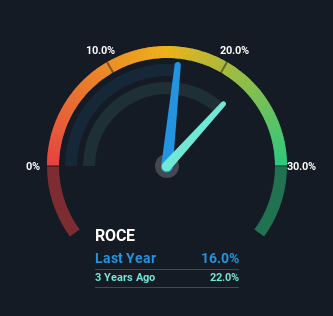- Hong Kong
- /
- Construction
- /
- SEHK:9900
There Are Reasons To Feel Uneasy About Gain Plus Holdings' (HKG:9900) Returns On Capital
If we want to find a stock that could multiply over the long term, what are the underlying trends we should look for? Firstly, we'll want to see a proven return on capital employed (ROCE) that is increasing, and secondly, an expanding base of capital employed. Put simply, these types of businesses are compounding machines, meaning they are continually reinvesting their earnings at ever-higher rates of return. Having said that, from a first glance at Gain Plus Holdings (HKG:9900) we aren't jumping out of our chairs at how returns are trending, but let's have a deeper look.
Return On Capital Employed (ROCE): What Is It?
For those who don't know, ROCE is a measure of a company's yearly pre-tax profit (its return), relative to the capital employed in the business. Analysts use this formula to calculate it for Gain Plus Holdings:
Return on Capital Employed = Earnings Before Interest and Tax (EBIT) ÷ (Total Assets - Current Liabilities)
0.16 = HK$49m ÷ (HK$402m - HK$97m) (Based on the trailing twelve months to September 2023).
Therefore, Gain Plus Holdings has an ROCE of 16%. In absolute terms, that's a satisfactory return, but compared to the Construction industry average of 7.8% it's much better.
Check out our latest analysis for Gain Plus Holdings

While the past is not representative of the future, it can be helpful to know how a company has performed historically, which is why we have this chart above. If you'd like to look at how Gain Plus Holdings has performed in the past in other metrics, you can view this free graph of Gain Plus Holdings' past earnings, revenue and cash flow.
How Are Returns Trending?
In terms of Gain Plus Holdings' historical ROCE movements, the trend isn't fantastic. To be more specific, ROCE has fallen from 27% over the last five years. Meanwhile, the business is utilizing more capital but this hasn't moved the needle much in terms of sales in the past 12 months, so this could reflect longer term investments. It may take some time before the company starts to see any change in earnings from these investments.
On a related note, Gain Plus Holdings has decreased its current liabilities to 24% of total assets. That could partly explain why the ROCE has dropped. What's more, this can reduce some aspects of risk to the business because now the company's suppliers or short-term creditors are funding less of its operations. Some would claim this reduces the business' efficiency at generating ROCE since it is now funding more of the operations with its own money.
What We Can Learn From Gain Plus Holdings' ROCE
In summary, Gain Plus Holdings is reinvesting funds back into the business for growth but unfortunately it looks like sales haven't increased much just yet. Unsurprisingly, the stock has only gained 2.6% over the last five years, which potentially indicates that investors are accounting for this going forward. Therefore, if you're looking for a multi-bagger, we'd propose looking at other options.
If you'd like to know about the risks facing Gain Plus Holdings, we've discovered 2 warning signs that you should be aware of.
While Gain Plus Holdings may not currently earn the highest returns, we've compiled a list of companies that currently earn more than 25% return on equity. Check out this free list here.
Valuation is complex, but we're here to simplify it.
Discover if Hong Kong Zcloud Technology Construction might be undervalued or overvalued with our detailed analysis, featuring fair value estimates, potential risks, dividends, insider trades, and its financial condition.
Access Free AnalysisHave feedback on this article? Concerned about the content? Get in touch with us directly. Alternatively, email editorial-team (at) simplywallst.com.
This article by Simply Wall St is general in nature. We provide commentary based on historical data and analyst forecasts only using an unbiased methodology and our articles are not intended to be financial advice. It does not constitute a recommendation to buy or sell any stock, and does not take account of your objectives, or your financial situation. We aim to bring you long-term focused analysis driven by fundamental data. Note that our analysis may not factor in the latest price-sensitive company announcements or qualitative material. Simply Wall St has no position in any stocks mentioned.
About SEHK:9900
Hong Kong Zcloud Technology Construction
An investment holding company, engages in the provision of subcontracting works for public and private sectors in Hong Kong.
Flawless balance sheet with solid track record.
Market Insights
Community Narratives



